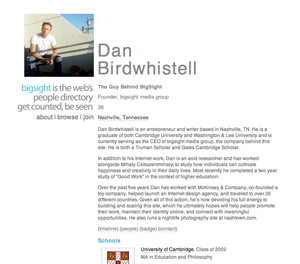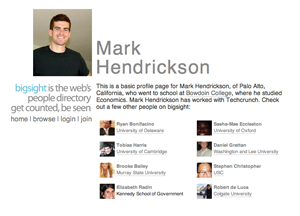While we’ve covered the people search sector, and Facebook’s entrance into that sector, we have yet to profile a nascent site called BigSight that seeks to become the go-to web destination for people profiles.
BigSight differs from other people search sites like Wink and Spock by focusing on the creation of a centralized repository of profile information rather than crawling the web to collect personal information from disparate sources. It also differs from resources like Wikipedia by encouraging the creation of profiles for any and everyone, not just people who clear a subjective “prominence” bar.
Profiles on BigSight are created by individuals themselves, as in the case of social networks, and you must sign into the site before you can edit your profile. It’s not an open wiki by any means, and site editors only make minor changes to profiles. Users are encouraged to update their public profiles every quarter, and profiles that go untouched for more than two quarters risk removal from the directory.
The site is fairly simple in its current incarnation. Profiles display a full name, a portrait, an activity/job description, an age, a location, and a third-person description. You can also view a resume (if uploaded), a timeline of the person’s life, a list of associated people, an embeddable BigSight badge, and a contact form. Members of BigSight are organized into groups and work/school associations. To see what I mean, you can view my profile here and members of the American Medical Association here.
BigSight currently has a mere 1,000 users, so its biggest challenge will be to create a critical mass that will drive usage and awareness. To do this, co-founders Dan Birdwhistell and Ben Sinclair have sought to leverage a large repository of private profile information: Facebook. They are actually the creators of a Facebook application we covered called FriendCSV that allows you to export much of your friends’ profile information out to an Excel-ready CSV file. They have also just released an application called Backuper that lets you export not only profile data but the photos you’ve uploaded to Facebook as well, all while syncing email address data from your Gmail account (Facebook’s platform doesn’t allow for the export of contact information).
In an impressive example of how developers can leverage the Facebook platform to get people to an external site, the founders have designed these Facebook apps to automatically set up a basic profile on BigSight with your Facebook profile data. After you run either of these backup programs, you will be notified of the creation of a BigSight profile, which contains a third-person description constructed from the information you gave Facebook. You can see the BigSight profile created from my Facebook profile to the right. Users have the option of deleting this profile or adding additional information to it. If the user simply does nothing with his or her BigSight profile, it will disappear after a few months.
Similarly, if you go to fb.bigsight.org, you can set up a BigSight profile by using your Facebook profile as a starting point and providing missing pieces like an email address. All you need to do is enter your Facebook credentials to pull the data out from Facebook. Birdwhistell says that this usage of Facebook data is completely within Facebook’s terms of service, and he expects many other services with user profiles to begin giving new users option of building their presence starting with their Facebook information.


